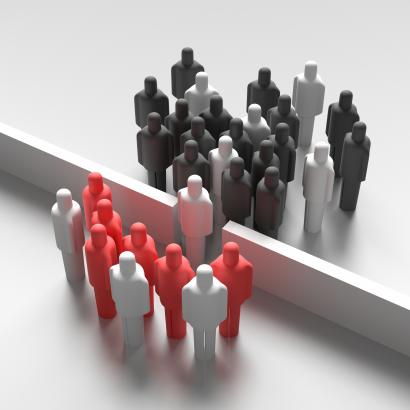- International Affairs
- History
- Contemporary
- Law & Policy
- Civil Rights & Race
Cribbing from Barack Obama, Germany’s Chancellor Angela Merkel rendered “Yes we can” as wir schaffen das, literally “we can do it.” In August, she flung open Germany’s gates to the asylum seekers scrambling into Europe. By year’s end, 1.1 million people had decided to find out whether Germany can.
In August 36,000 came. In the first two weeks of January, it was 52,000, belying hopes that nasty winter weather would give the nation a respite from goodness. Add them to the 1.1 million people who had tested Berlin’s open-door policy last year: refugees fleeing war in Syria and Iraq, but also economic chancers from the Balkans, Africa and Pakistan. And now it looks like Germany can’t do it after all.
Germany was destined to be Europe’s Promised Land. Mindful of its Nazi past, the country makes asylum a constitutional right. “Persons persecuted on political grounds,” Article 16 flatly states, “shall have the right of asylum.” No ceilings.
In a country that doesn’t allow for regular immigration the way the U.S. does, “asylum” is the open-sesame. Yet in real life, there are limits. And so, Germany is running up against an iron law: The immigration rate must not exceed the assimilation rate. Why did Sweden, Europe’s moral superpower, finally seal its borders?
The numbers tell the tale. In 2014 there were 8.3 refugees living in Sweden per 100,000 residents. Last year, the ratio had doubled to 16.6. So no more “Schengenland,” that borderless space from Lisbon to Lodz. Now it’s identity checks and drastically tightened asylum rules. Denmark quickly followed.
In Germany, the ratio had quintupled over the same period, to 13.5 from 2.5. Mrs. Merkel stuck to “yes, we can” in her New Year’s Eve address. Unfortunately, a thousand young Muslim men called her out on it a few hours later by terrorizing women of all ages passing through Cologne’s Main Station and Cathedral Square outside.
Young Christian males also don’t always obey Miss Manners when traveling in packs. But their culture doesn’t have a word for taharrush gamea, as practiced in some Arab lands: a group-grope where young men encircle women to jeer, molest and rob them. Hundreds of women have filed charges. Two-thirds of the newcomers from Afghanistan, Iraq and Syria are men below the age of 33. More than half of them are below 25. Overwhelmingly unattached, they don’t live under the civilizing influence of mothers, sisters or wives.
Acculturation into the strict sex codes of the West takes years, whereas the next batch of 50,000 is due this month, at current rates. With their legendary organizational prowess, Germans at all levels, state and private, have done an exemplary job of absorbing the influx on a day-by-day basis.
Take Munich Central Station, the main port of entry at the end of the “Balkan route” from Turkey to Germany. Off the train, the migrants are whisked away to school gymnasiums and empty army barracks. There, volunteers take over, handing out food and clothes from mountains of private donations. Others teach German or take the kids to the zoo.
Yet such Band-Aids are the easiest step. The demands of real integration—jobs and housing, not to speak of culture—will make mincemeat out of “we can do it” if uncontrolled immigration continues at one million a year, which relative to Germany’s population is equivalent to four million flooding into the U.S. annually.
Sadly, these asylum seekers are the “wrong” people for the wrong economy. Low-skill jobs fetching a decent wage are waning throughout the West, but only one-quarter of Iraqis come with completed vocational training. There are no reliable numbers, but back home, argues Munich economist Ludger Wössmann, two-thirds of young Syrians are “functional illiterates by international standards.” Tino Sanandaji of the Stockholm Business School told the Frankfurter Allgemeine Zeitung: “It takes an average of seven years before a refugee gets a steady job.”
Germany’s restrictive housing and land laws are good at inhibiting asset-price bubbles, but bad at meeting rapidly surging demand. With its mandated high wages and low tolerance for hire-and-fire, the German labor market is the worst enemy of immigrants. They cannot play out their inherent competitive advantage by selling their labor at a lower wage as tens of millions of newcomers have done in the U.S.
How about starting a little corner store? In an immigration country like Canada it takes two days to register a business. In Germany it’s 15, not counting health checks and exams in commercial and tax law. Driving for money? Uber has essentially given up on Germany where guilds and local governments have put up insurmountable hurdles.
All told, Germany as well as the European Union favor the haves at the expense of those who want to have, the insiders, not the outsiders. Add the pernicious effect of a lavish welfare state that provides asylum applicants with generous stipends, housing allowances and free health insurance. This largess doesn’t sharpen incentives to rush into a sclerotic labor market.
Nor does it amuse the natives who ask: “Why them, and not us?” You can’t have open borders and a munificent welfare state. Something has to give. Since even Mighty Merkel cannot overturn ancient dispensations, she will inevitably slip into “No, we can’t” and close borders, as the Swedes and Danes have done. High-mindedness stops at the ballot box.
Mr. Joffe is editor of Die Zeit in Hamburg and a fellow of the Institute for International Studies and the Hoover Institution, both at Stanford.
















